 |
||
| Travel Photos Home Page |
Travel Photos...SIngapore, 2019
|
||||
|
In January, 2019, I had a three night stopover in Singapore.
To beat the Equatorial heat, I got up each day before dawn and ventured out to explore this vibrant city state. |
|||
|
To return to the Paintings section of this website, please CLICK HERE
|
|||
 |
|||
| Singapore has had a long and turbulent history long before the British colonised it in 1819. This is hardly surprising when we study its strategic location at the Southern tip of the Malacca Strait. It is ideally placed as a trading port.
Below is a brief list of its historical periods since the year 650. Srivijaya 650–1377 |
|||
 |
|||||||||
| Sir Stamford Raffles was the key figure in the eventual establishment of Singapore as a British Colony.
Raffles was a fascinating character. I was amused to read that, when he died in England at the age of just 45, he was refused burial at his local parish church by the vicar, Theodor Williams, whose family had made its money in Jamaica in the slave trade. Raffles had been instrumental in attempting to abolish slavery in South East Asia. Singapore as a vital trading port began as an outpost of the East India Company before it became a possession of the British Empire. It was occupied by the Japanese during the Second World War. Singapore became an independant Republic in 1965. |
You can see from the map above that Singapore is not a large piece of real estate. That has not stopped it from becoming a dynamic and prosperous City State. |  |
|||||||
|
Sir Thomas Stamford Bingley Raffles
(1781 - 1826) |
|||||||||
 |
|||
| Flying towards Changi Airport, we passed over countless islands. I have no idea which nation owns the ones in the photo above. That looks like an elegant tourist resort, with houses perched over the water. If anoyone knows where this island is, please email me the answer! | |||
 |
|||
| Changi Airport is without doubt one of the most well appointed airports in the world. It is huge and has 4 Terminals. | |||
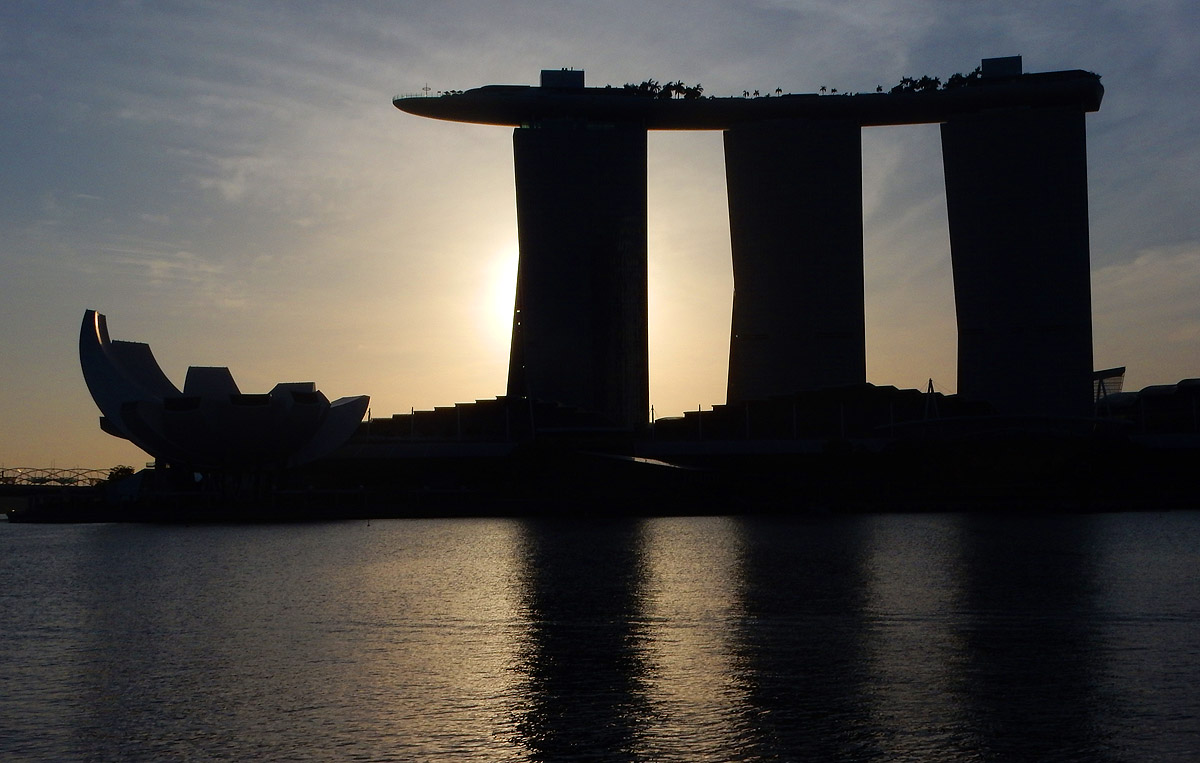 |
|||
| To beat the Equatorial heat, I woke up each morning before dawn to explore the city. This is a dawn shot of two iconic new buildings in Singapore. The three-legged building on the right is the Marina Bay Sands, and the lotus shaped building on the left is the Art and Science Museum.
This photo was taken close to another Singapore icon: the Merlion. When Singapore as a British Colony was in its infancy, it was sometimes known as the Lion City. |
|||
 |
|||
| The Merlion, facing North. | |||
 |
|||
| Close by is Downtown, the business district, with its modern office buildings. | |||
 |
|||
| Raffles Place is in the Downtown District.
The small building in the foreground, behind the palm trees, is an entrance to the MRT, a super efficient underground rail system. The MRT is the best way to qucikly get around the city, as there are a large number of stations, strategically placed. |
|||
 |
|||
| The smaller pedestrian bridge in this photo will take you across the water to the Theatres on the Bay. | |||
 |
|||
| This view shows the belly of the main bridge in the preceeding photo. | |||
 |
|||
| Cavenagh Bridge, one of several structures which span the Singapore River. | |||
 |
|||
| This shot was taken from the roof of the Shoppes at Marina Bay Sands. The Merlion is in the foreground and the old Victoria Memorial Hall is the white building further back.
The photo was taken with the full 30 X optical zoom of the camera, so the distance between the Merlion and the Victoria Hall appears to be much closer than it is in reality. The actual space between these two landmarks has been 'flattened'. |
|||
 |
|||
| These are the 'Shoppes' mentioned above. It is a huge shopping mall, which includes a casino, I believe. | |||
 |
|||
| And this is a view of the Marina Bay Sands main structure, taken from the Gardens by the Bay. It is a 5 star hotel. | |||
 |
|||
| Fortunately, quite a few old buildings from the Colonial era are still in existence. This is the Central Fire Station on Hill Street. | |||
 |
|||
| The National Gallery on St Andrew's Road.
It is the Museum of Singapore and Southeast Asian arts and it is housed in a restored municipal building dating from 1929. |
|||
 |
|||
| Chinatown is a very popular district. It has a large number of restaurants and it seems to be bustling with people, both locals and tourists, during the day and night. | |||
 |
|||
| Chinatown at night. | |||
 |
||
 |
|||
| The nickname for this road is Food Street. | |||
 |
|||
| Getting ready for the Year of the Pig.
Gung Hei Fat Choi! |
|||
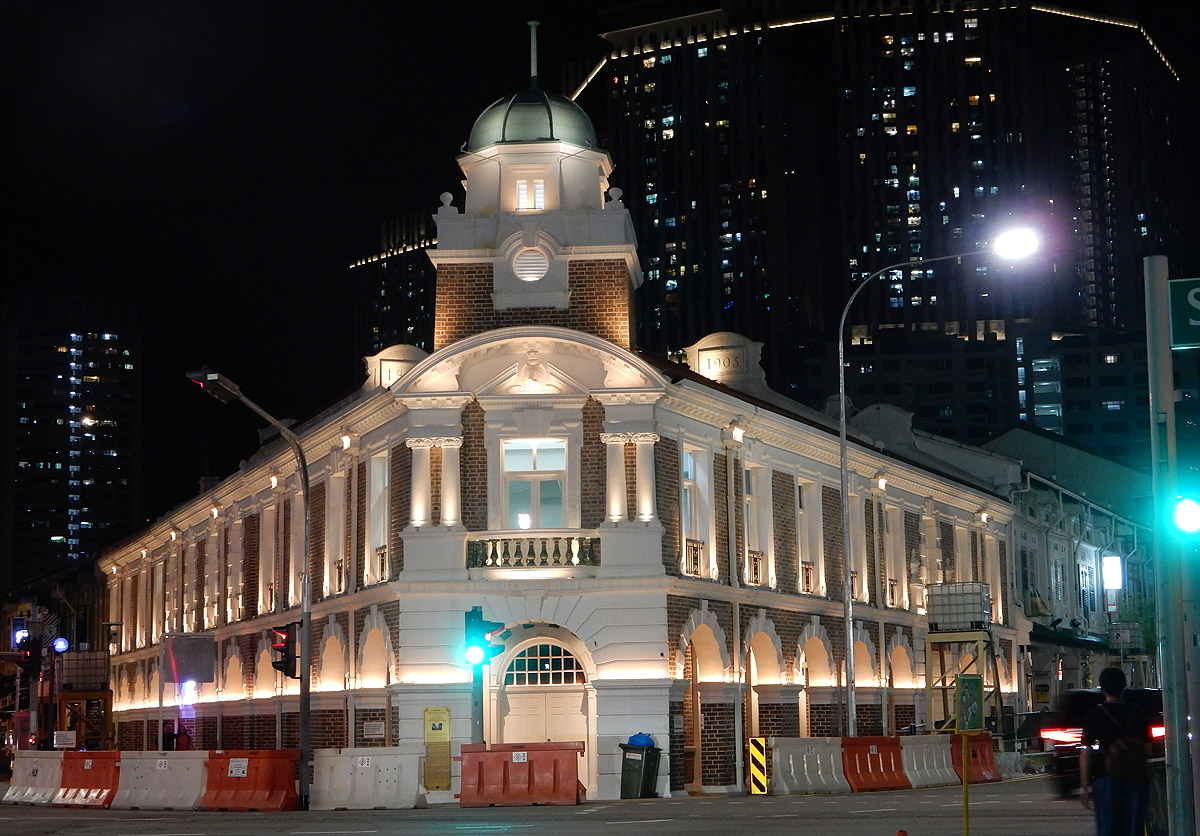 |
||||
| This is the Jinrikisha Station in Chinatown. I am quoting Wikipedia below: | ||||
| "Situated at the junction of Neil Road and Tanjong Pagar Road, the Jinrikisha Station is Singapore's last reminder of the once ubiquitous rickshaw. Rickshaws were small, light-weight carts with springs and large wheels. The rickshaw puller worked two shafts protruding from the front of the rickshaw and ran between them. The rickshaw was first imported from Shanghai to Singapore in 1880 and by 1888, a Jinricksha Department was set up to register and license each rickshaw. By the end of the 19th century, there were about 1,000 rickshaw owners in Singapore. The demand for rickshaws was so great that Japan began manufacturing cheaper versions. The Jinrikisha Station was built from 1903 to 1904. Its location was ideal for catering to customers from the nearby Tanjong Pagar Docks and the adjacent thoroughfare that led from the docks to the town. By 1919, there were 9,000 rickshaws manned by 20,000 rickshaw pullers working in shifts. The life of a rickshaw puller was harsh. Most could not afford to own a rickshaw and had to rent one. Rickshaw pullers lived in cramped cubicles in shophouses in Chinatown and earnings were meagre. To ease their heartaches as well as their overworked bodies, many turned to opium. Until 1904, all the rickshaws were two-seaters, which were heavy and often used to transport whole families and commercial goods; the weight was almost unbearable for the rickshaw pullers. In 1911, the government tried to ban the two-seater rickshaw, but opposition delayed the passing of this law for another three years. However, when it was finally implemented, it proved ineffective. Fortunately, the single-seater soon emerged as the more popular rickshaw and the two-seater faded into disuse. Rickshaws were gradually replaced by other means of transport: the trishaw, the electric tram, the bus and the car. After World War II (1942-1945), they were phased out by government legislation and the once familiar sight of rickshaws and rickshaw pullers disappeared forever from the streets of Singapore. " |
||||
 |
|||
| Not far from Chinatown is Little India. | |||
 |
|||
| A street in Little India. | |||
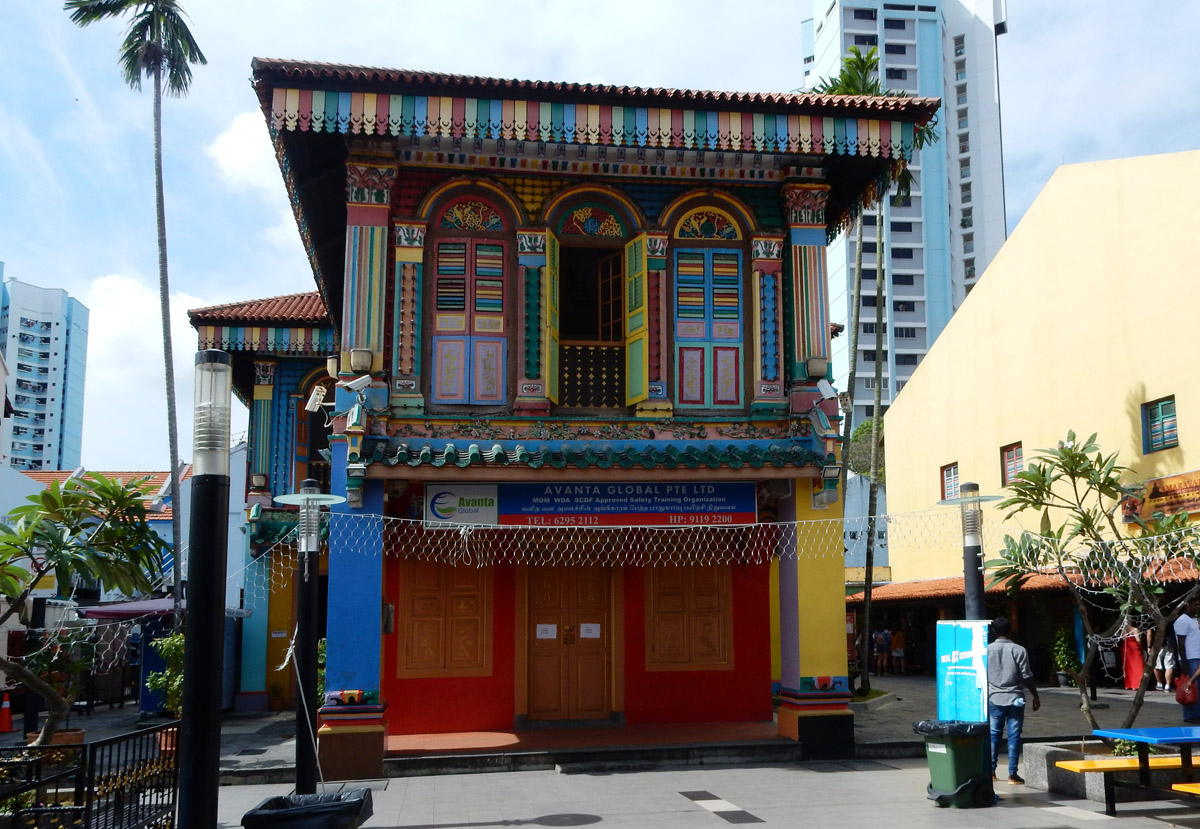 |
|||
| A colourful building in Little India. | |||
 |
|||
| Along the banks of the Singapore River, we find old residential buildings, with restaurants and cafes hugging the stone bank of the river. | |||
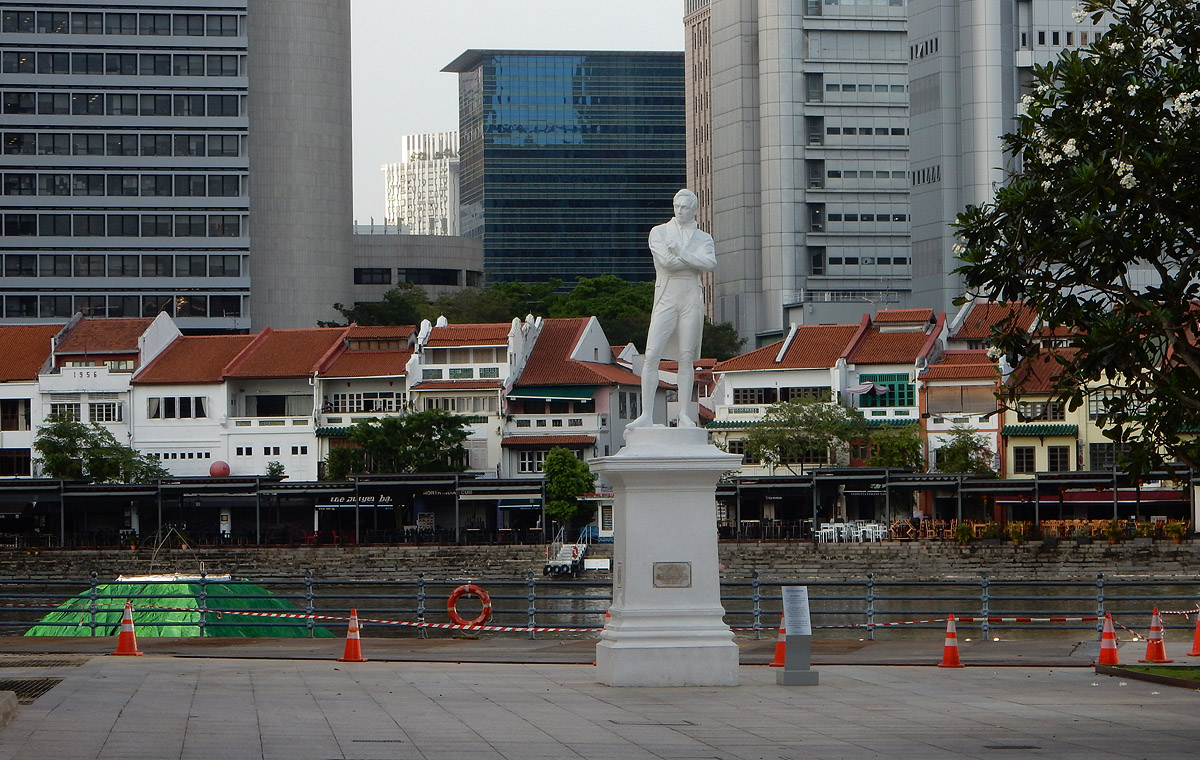 |
|||
| This white marble statue of Sir Stamford Raffles is on the Northern bank of the Singapore River. | |||
 |
|||
| River craft of all sizes and shapes take tourists on trips along the river and on the bays. | |||
 |
|||
| This district is called Harbour Front. A large cruise ship is docked here, and the cable cars take visitors to the island of Sentosa on the opposite shore. | |||
 |
|||
| The tall cranes remind us that Singapore is a dynamic container port. The pink skytrain is heading towards the amusement district of Sentosa.
A causeway now joins Sentosa with the main island of Singapore. |
|||
 |
|||
| A few kilometres from Harbour Front, we come across Orchard Road, famous as a shopping paradise. This is one of the malls there. | |||
 |
|||
| Glitz on Orchard Road. | |||
 |
|||
| A highlight of my brief visit to Singapore was the Gardens by the Bay. These gardens were created in 2012 on reclaimed land They occupy 101 hectares (or 250 acres).
The photo above shows some of the Supertrees, with the Marina Bay Sands Hotel in the background. A lush tropical garden and lake in the foreground completes this picture. |
|||
 |
|||
| Visitors can walk along the OCBC Skyway between two of the larger Supertrees. | |||
 |
|||
| This photo of the Supertrees was taken from the Cloud Forest, which is featured next. | |||
 |
|||
| The Cloud Forest is contained within a massive glass dome. | |||
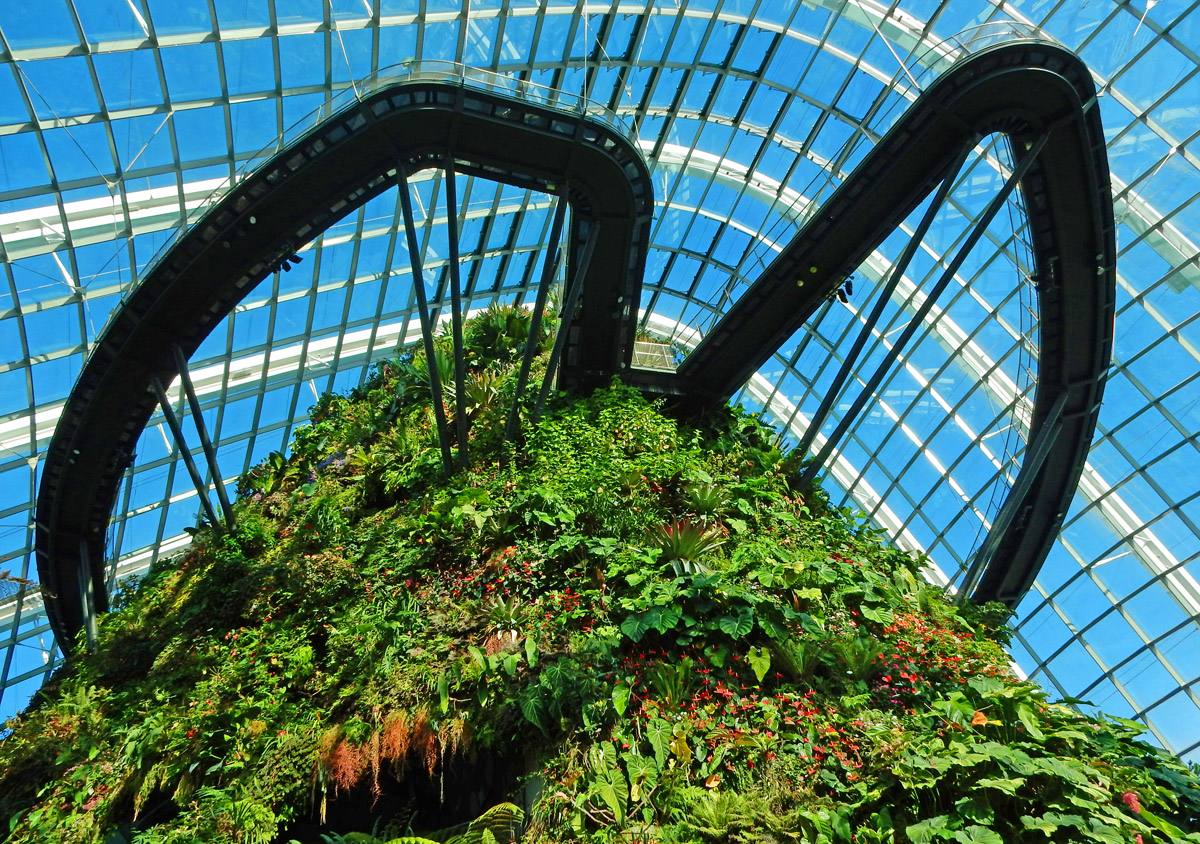 |
|||
| You can take a lift up to the top of the artificial "mountain" inside the Cloud Forest. | |||
 |
|||
| If you don't suffer from vertigo, you should definitely stroll along the two levels of flying walkways, which jut out on steel legs from the "mountain". | |||
 |
|||
| On the top skywalk in the Cloud Forest. | |||
 |
|||
| The carefully monitored temperature controls within the Cloud Forest ensures that it is bursting with flowers and shrubs of all kinds. | |||
 |
||
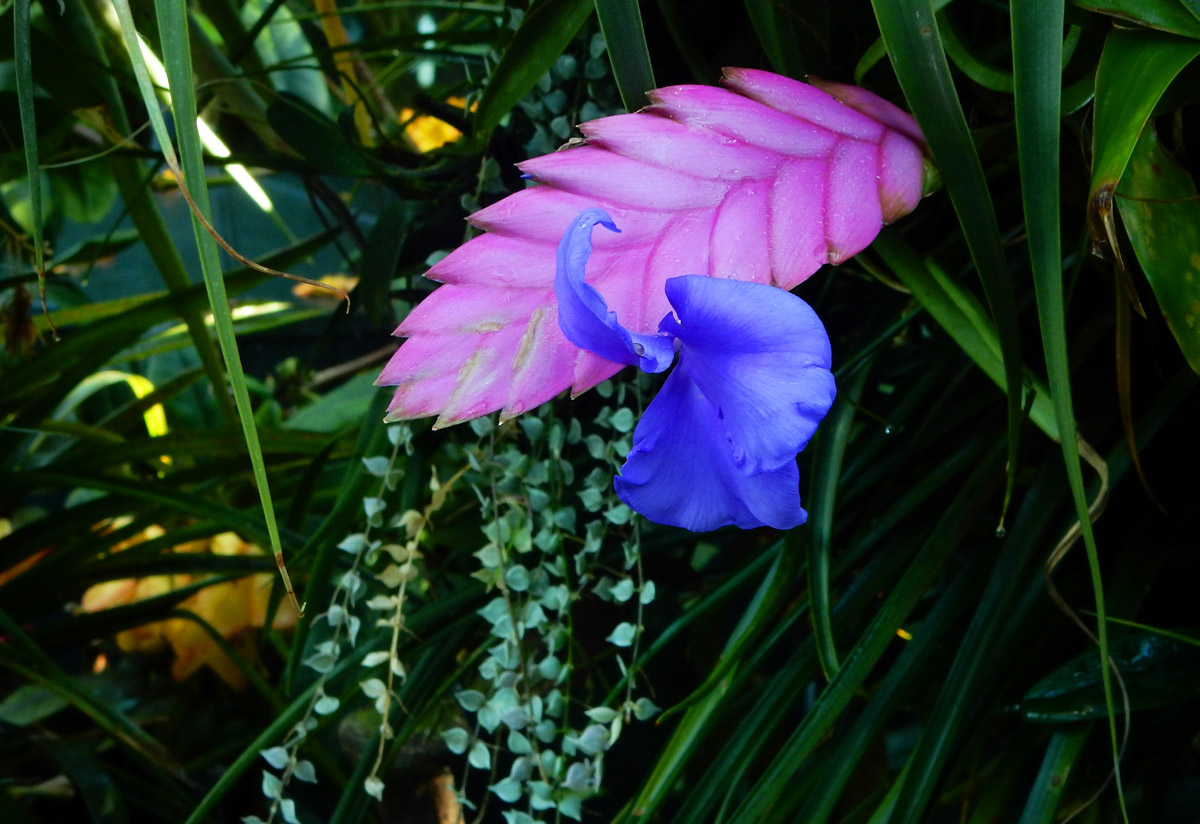 |
||
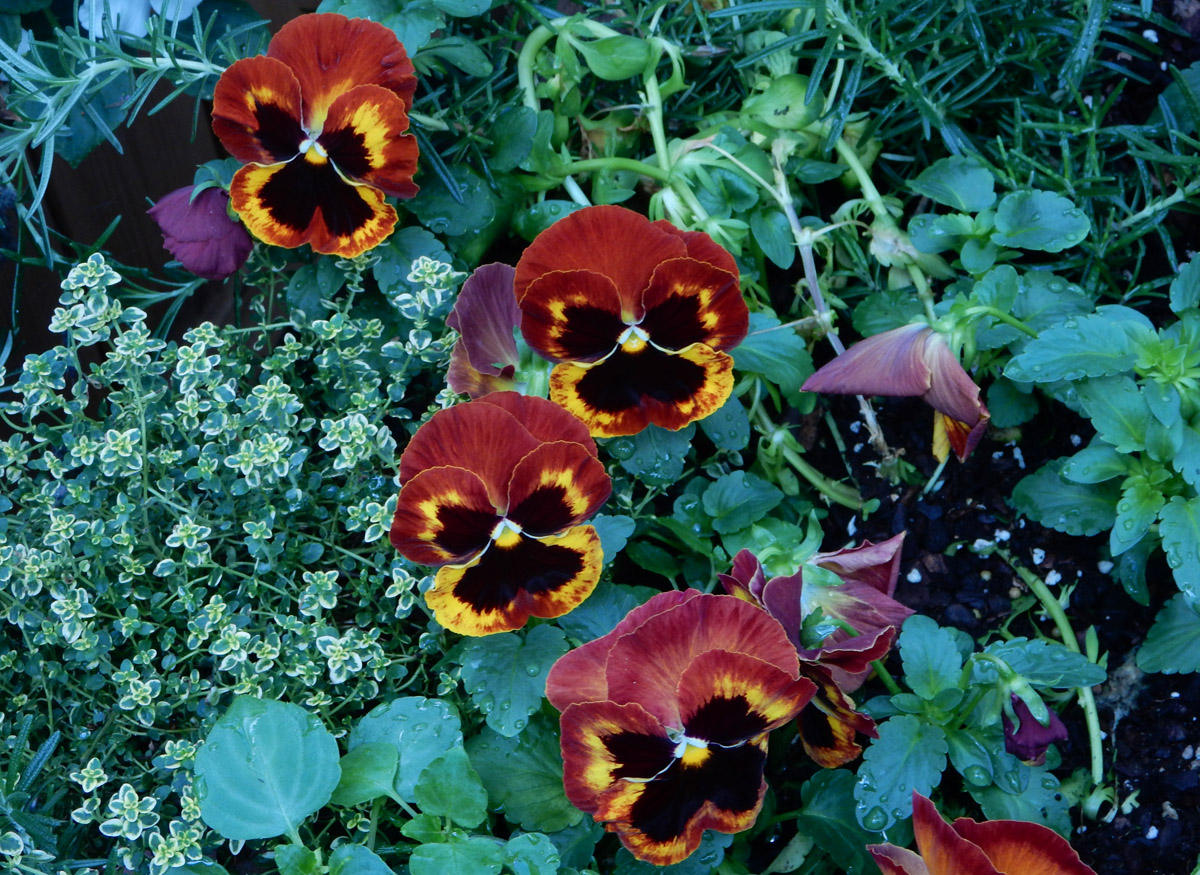 |
||
 |
|||
| This is a view looking down from the top skywalk onto the lower level. | |||
 |
|||
| Next to the Cloud Forest, there is the Flower Dome. It maintains a mild, dry climate and features plants from the Mediterranean, Australia, South America and South Africa. | |||
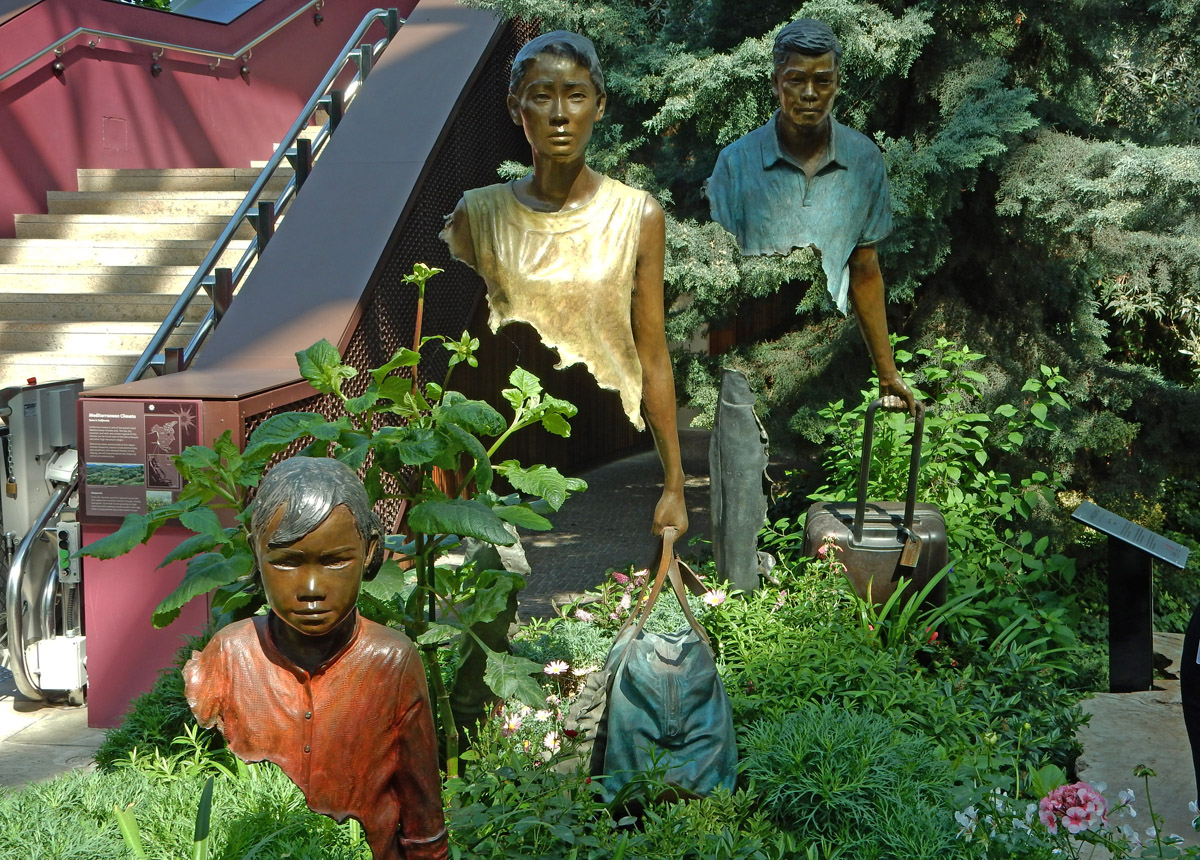 |
|||
| We end our short visit to Singapore with this view of a small family, enjoying the Flower Dome within the Gardens by the Bay. | |||
|
To return to the Paintings section of this website, please CLICK HERE
|
|||